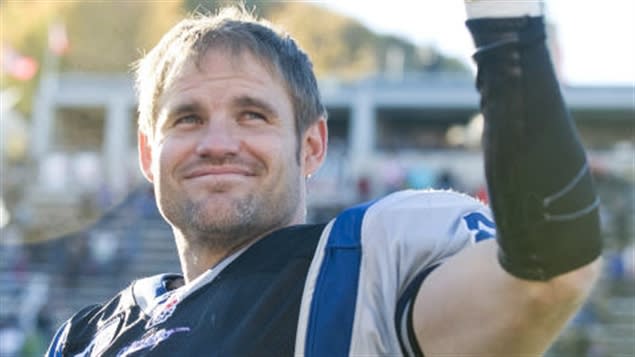Five things to remember about Ben Cahoon's career

The Montreal Alouettes' announcement this week that they're going to officially retire former slotback Ben Cahoon's number 86 jersey during a halftime ceremony at their July 29 game against the Saskatchewan Roughriders makes a lot of sense. Cahoon, who's currently the receivers coach at Utah's Brigham Young University (his alma mater), had a legendary 13-season career with the Alouettes from 1998-2010 and was selected for the Canadian Football Hall of Fame in 2013. He's one of the most impressive, talented and popular Montreal players in recent decades, and he thoroughly deserves this honour. It's also a great chance to look back at five remarkable facets of his unique career, and how he impacted the CFL.
1. The helmet catch: Two years after David Tyree's famed helmet catch in the 2007 Super Bowl, Cahoon made an impressive one of his own. The really cool part? He used a defender's helmet.
2. The non-Canadian Canadian: The CFL separates players into what are essentially Canadian and American classes, although it calls them non-imports and imports (or nationals and internationals under the 2014 CBA). There's a fascinating historical reason for that. The import rule was first brought in ahead of the 1936 season in reaction to the 1935 Grey Cup win by the Winnipeg 'Pegs (the first championship for a team west of Ontario), who fielded a team with eight American players. Players were then required to be Canadian residents until 1946, when five Americans were allowed, and several changes were made from there through 1965, which saw a successful Ontario Human Rights Tribunal challenge from American-born player who had previously qualified as a "naturalized Canadian" after several years in the CFL, but then lost his job when that limit was lowered. That tribunal ruled the CFL was unlawfully discriminating, so Bora Laskin (then the dean of Toronto's famed Osgoode Hall law school, later the chief justice of the Supreme Court of Canada) drew up a plan for the CFL to legally keep its Canadian content, basing import/non-import status on where a player received his football training (or where he lived growing up), not his birthplace or citizenship.
For the majority of players, birthplace/citizenship and training aligned. They didn't in some cases, though, and Cahoon's one of the most prominent. He was born in Orem, Utah, but was counted as a non-import by the CFL thanks to spending much of his childhood in Cardston, Alberta. That led to some weird nomenclature situations, especially when he was named the CFL's Most Outstanding Canadian in back-to-back years in 2002 and 2003, but it also proved to be a very good thing for the CFL in the long run. If he was considered an import, the 5'9'', 185-pound Cahoon might not have received much of a look coming out of college at BYU despite his impressive production. As a non-import, though, he was a first-round draft pick by Montreal. Cahoon's talent wouldn't have changed either way, but the Alouettes regarded him more highly thanks to that quirk of the import rules, and that paved the way for an outstanding career, one that provided major contributions to Canada.
3. The unconventional receiver: Many star CFL receivers have been exceptionally big, exceptionally fast or both, but Cahoon was neither. He also excelled on routes over the middle, which were traditionally the domain of big guys who could make catches in traffic. Cahoon made tons of contested catches of his own, though, and frequently showed off impressive coordination, a good burst off the line, and a terrific set of hands. That made him a 10-time divisional all-star and a three-time league all-star. Check out this diving catch he made against the Riders in 2007:
4. The Calvillo connection: Cahoon came to Montreal in 1998, the same year as legendary quarterback and all-time pro football passing leader Anthony Calvillo, and the chemistry between the two was a large part of the success both found. Calvillo started his Alouettes' career backing up Tracy Ham, only starting five games in 1998 and nine in 1999, while Cahoon posted 471 receiving yards in his first season and 846 in 1999, and both really made the jump together in 2000. Calvillo started 17 of the Alouettes' 18 games and threw for 4,277 yards, while Cahoon made 71 catches for 1,022 of those yards. They'd have even better seasons together (5,891 and 1,561 yards respectively in 2003 really stands out), and they'd post a lot of great statistics as a result of their pairing and win three Grey Cups together (in 2002, 2009 and 2010). Cahoon's sure hands and ability to make catches in traffic made him perfect for Calvillo and his accuracy-focused high-percentage passing attack. It's no surprise that Cahoon posted eight 1,000-yard receiving seasons in a row working with Calvillo.They were one of the CFL's best quarterback-receiver duos, and a rare one to stick together and produce at a high level for so long.
5. The kicker: Cahoon was also one of the rare receivers to successfully kick a field goal, nailing this game-winning overtime one against Toronto in 2007 after Montreal kicker Damon Duval was ejected for fighting:
Those are just five of the many memorable moments of Cahoon's career. It's great to see the Alouettes honouring him, and it's appropriate that they're retiring his number. It's hard to imagine any other Montreal receiver living up to #86.

 Yahoo Sports
Yahoo Sports 

